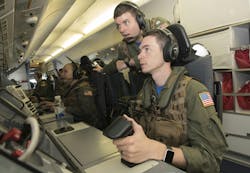RTX BBN to upgrade P-8A Poseidon anti-submarine warfare (ASW) signal processing for multistatic sonobuoys
Summary points:
- RTX BBN will enhance software for multistatic sonobuoy operations aboard the P-8A Poseidon ASW aircraft.
- Upgrades involve sonobuoy signal processing, MIMO capabilities, and new operator interfaces to help detect submarines in challenging conditions.
- As the original GRS designer, RTX BBN continues sole-source support to maintain compatibility across evolving P-8A systems through 2030.
PATUXENT RIVER NAS, Md. – U.S. Navy anti-submarine warfare experts needed software engineering to enable the P-8A Poseidon maritime patrol jet to use multistatic sonobuoy capabilities to detect and pinpoint enemy submarines in difficult conditions. They found a solution from RTX BBN Technologies Inc. in Cambridge, Mass.
Officials of the Naval Air Systems Command at Patuxent River Naval Air Station, Md., announced a $12.9 million contract earlier this month to upgrade and modify the Ground Replay System (GRS) used with the P-8A.
The GRS is for high-fidelity acoustic mission reconstruction of sorties from the P-8A anti-submarine warfare (ASW) aircraft; the GRS enables Navy ASW efforts to stay in lock-step with P-8A acoustic capabilities.
RTX BBN experts will ensure that the GRS software algorithms and displays remain in alignment with Navy ASW systems, and remain backwards-compatible with previous P-8A aircraft versions.
Submarine-hunting upgrades
Raytheon BBN engineers will handle software development and upgrades to keep the P-8A Poseidon's ASW systems up to date with new multistatic active coherent (MAC), MAC enhancements, and multiple input multiple output (MIMO) capabilities of the new AN/SSQ-101C and the AN/SSQ-125B sonobuoys.
Company experts also will handle undersea advantage (USA) receiver sonobuoy array modifications; next-generation MAC-E active and passive sonobuoy signal processing; new operator machine interface designs; high-duty-cycle capabilities; and will demonstrate other advanced processing concepts.
The AN/SSQ-101 Air Deployed Active Receiver (ADAR) sonobuoy provides a commandable passive search capability, and functions as the receiver in a multistatic active receiver system. The device uses a pentagon-shaped horizontally oriented pattern of hydrophones to detect and beam form underwater sound waves.
The AN/SSQ-125 sonobuoy is a source in a multistatic field, can generate a variety of waveforms, and is designed to work with the AN/SSQ-53F, AN/SSQ-77C, and AN/SSQ-101 ADAR sonobuoys.
A multistatic sonar system contains several spatially diverse monostatic or bistatic sonar components with a shared area of coverage, and enable Navy ASW operators to use sensor fusion to combine the power of the separate sonobuoys.
The AN/SSQ-125’s RF channel can be programmed to any of the standard sonobuoy operating channels. At any time after deployment, the AN/SSQ-125 can be commanded to change its operating parameters or depth (deeper only), generate a ping, or scuttle.
The Navy awarded this contract to RTX BBN sole-source, because this company won the original GRS contract in April 2002. The company won subsequent sole-source upgrade contracts in June 2005, February 2007, June 2010, and March 2015. RTX BBN is the sole designer and developer of the GRS.
On this contract, RTX BBN will do the work in Cambridge, Mass., and should be finished by June 2030. For more information contact RTX BBN online at https://www.rtx.com/who-we-are/we-are-rtx/transformative-technologies/bbn, or Naval Air Systems Command at www.navair.navy.mil.
About the Author
John Keller
Editor-in-Chief
John Keller is the Editor-in-Chief, Military & Aerospace Electronics Magazine--provides extensive coverage and analysis of enabling electronics and optoelectronic technologies in military, space and commercial aviation applications. John has been a member of the Military & Aerospace Electronics staff since 1989 and chief editor since 1995.

